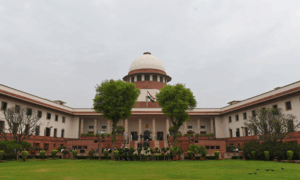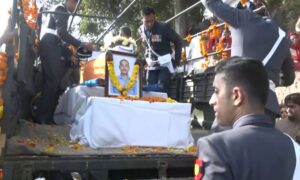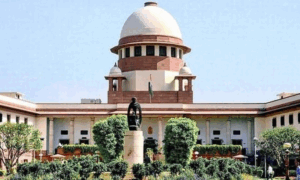
A common sight or practice in the countryside of a developing country is people going out of their homes to defecate in the open. Generally, toilets are not constructed within premises due to a number of reasons, i.e., defecating within the house is considered unholy; the practice pollutes the house; some households are either not in a position to construct and maintain hygienic toilets, or do not have sufficient space to construct; or water for cleansing is not available.
In settlements where some houses have toilets, the underground sewerage network is not available. Here, excreta are released in nearby open areas/drains/water bodies, or removed by manual scavengers.
Country-level data show India having the largest number of people defecating in the open and the proportion is decreasing at a very slow rate. Further, as per the Swachhta Status Report, 2016 released by the Ministry of Statistics and Programme Implementation, and which draws upon data of Census and National Sample Survey, 52.1 percent rural, 7.5 percent urban population of India goes for open defecation.
The impact of defecating in nearby secluded open areas, bushes and water bodies (such as rivers, ponds) is severely felt on human health, productivity and environment.
In India, 117,000 children under five years of age die every year due to diarrhoea (this is about 22 percent of the global burden), 38 percent are stunted (do not meet potential growth, development, physically and mentally), 14 percent neo-natal deaths occur due to sepsis. Such problems are a result of inadequate access to safe drinking water, sanitation and hygiene, as well as an absence of infection prevention and control facilities. Any child not having access to adequate sanitation in early years faces health problems for the entire lifespan despite having proper food. Besides health risks, the life of girls and women is unsafe. Numerous incidents of rape and murder occur when females go out alone to urinate or defecate.
Such problems are preventable. Availability of adequate sanitation facilities and their usage by everyone can save lives, ensure nutrition, productivity, women’s security and dignity. For example, adequate sanitation can decrease the risk of stunting by 14 percent, and risk of severe stunting by 26 percent. This also attends to the problem of underweight, low height of children.
A recent initiative launched in India in 2014 to improve the situation of sanitation is the Swachh Bharat Abhiyan (Clean India Mission). The Mission aims to make India free from open defecation and achieve 100 percent scientific management of solid waste by 2 October 2019, said Mr. Parameswaran Iyer, Union Secretary in the Ministry of Drinking Water and Sanitation. He was delivering the keynote address at the roundtable discussion on ‘Swachh Bharat Mission: Achievements and Challenges’ organised in Delhi on July 7.
The roundtable was chaired by Mr. Surendra Singh, Advisor, ORF and former Union Cabinet Secretary. Panel speakers included Mr. Nisheeth Kumar, Chief, Operations, Knowledge Links; Mr. Nicolas Osbert, Chief – Water, Sanitation and Hygiene, UNICEF; Mr. Samirendra Chatterjee, Hony. Executive President, Sulabh International Social Service Organisation and Mr. Subhash Gatade, Author.
According to Mr Iyer, work is underway on construction of household, community and public toilets, and achieving improvements in the collection, processing and disposal of solid waste. A study is also being conducted by the government, in collaboration with UNICEF, to assess household savings / losses based on the quality of sanitation infrastructure and services available in settlements. Further, an annual survey is being undertaken to assess the sanitary condition of settlements, which will form the basis for responding to their cleanliness requirements.
It is realised that behavioral changes in the society about healthy sanitation practices are needed to achieve the mission goals. Hence, emphasis is laid on conduct of awareness generation programs, and citizen engagement in the reform process.
The key element of Swachh Bharat Abhiyan particularly in the context of rural areas is a shift from open defecation (OD) to use of toilets by triggering behavioural change at community level. It is envisaged that this will enable communities to talk about OD and usage of toilets. Importance is also laid on doing multiple levels of verification and media reporting to ensure that toilets are being built properly and people continue to use toilets even after the open defecation free (ODF) targets are achieved.
To make this happen, the central ministry is supporting State governments by way of providing financial incentives for solid/liquid waste management (SLWM), toilet construction, information education and communication (IEC), technical assistance and capacity building. For example in Rajasthan, efforts are being made to improve sanitation coverage by engaging with state functionaries and civil society.
A Swachh Bharat Kosh (fund) has been created in the finance ministry that allows public sector, corporates, individuals to contribute funds, which are being utilised for various Swachh Bharatinitiatives in the country. About INR 550 crores have been collected so far. Another initiative is Swachh Bharat Preraks, i.e., volunteers recruited by Tata Trusts for monitoring the progress of activities at the district level and thus accelerating efforts to achieve universal sanitation coverage.
Every government ministry has also developed Swachhta Action Plans that are funded mostly from their own budget for carrying out innovative activities for two years (2017-18, 2018-19). For example, agriculture ministry is focusing on cleaning of agricultural mandies. Highways ministry is building proper toilet facilities along highways at toll plazas. Similarly, the ministry of petroleum is doing the same at petrol stations.
Further, Swachh Iconic Places is yet another initiative undertaken to ensure adequate sanitation near iconic structures, such as the Golden Temple, Taj Mahal, temple at Tirupati, because of the large population visiting these sites.
Under another initiative, namely Swachh Swasth Sarvatra, launched in collaboration with the health ministry and with the help of UNICEF (which have developed the training curriculum), primary health centres are being sanitised by providing better facilities for cleaning, washing, etc. Also, along with the department of school education, toilets are being provided in government schools, and children are informed about the importance of hygiene and sanitation.
The Village Swachhta Index has also been developed which reflects aspects of ODF, SLWM, visual cleanliness, stagnant water, etc. Based on the prevailing sanitary conditions and improvements, panchayats have been asked to rank themselves on a three monthly basis on a scale of 0 to 10. The index is now available for 130,000 villages.
As reported by the Ministry of Drinking Water and Sanitation, since the launch of Swachh Bharat Abhiyan on 2 October 2014, the number of people in rural India practicing open defecation has come down from 550 million to 320 million, and the target is to make India ODF by 2 October 2019. Overall, rural areas in 5 states (Himachal Pradesh, Uttarakhand, Haryana, Sikkim and Kerala), 2 lakh + villages and 149 districts have been declared ODF. States with less than 50 percent sanitation coverage include Jammu and Kashmir, Uttar Pradesh, Bihar and Orissa.Numerous independent (NGO, private sector) and/or participatory (PPP) activities are also in operation.
Sulabh International Social Service Organisation, for example, has been in this field since the 1970s, said Samirendra Chatterjee of Sulabh. He said his organisation has built more than 1.5 million household toilets, about 20,000 toilets in schools, 8,500 public toilets on a pay and use basis. Importance is given to both IEC for convincing people, and building and maintaining toilets. Their twin-pit pour flush low cost toilet has helped in addressing the issue of manual handling (manual scavenging) of excreta.
Sulabh also works for the decomposition of human waste, which is made pathogen free, and then used as a bio-fertiliser in agricultural fields. A bio-digester has also been developed which decomposes human waste in a public toilet and converts it into methane that can be used for cooking, lighting, heating during winters. The facility (three bio digesters) is also available in public toilets constructed at Sai Baba temple in Nashik, where about 40-50,000 pilgrims use the toilets every day. These facilities (twin pit toilets and bio-digesters) are especially useful at places where sewer systems are not available. Sulabh’s model is such that it is self-sustainable and does not depend on external funds.
The UNICEF has been making a noteworthy contribution, said Nicolas Osbert of UNICEF. The agency works in 15 States covering 80 percent of the rural population. It believes that behavioural changes in society about healthy sanitation practices can come if the community is empowered. Thus, UNICEF assists villagers in recognising their problems, and using their knowledge to find effective solutions. Similar activities are pursued in healthcare centres, schools, aanganwadi centres, so that good habits are adopted by everyone on sanitation, toilet usage and handwashing. Capacity building programmes are also conducted in 130 districts for ensuring better planning and implementation of the budget.
To accomplish the sanitation goals, several institutions are working with the Ministry, namely UNICEF, World Bank, BMGF, Tata Trusts, several NGOs, such as Water Aid. Coordination among the institutions is important to avoid duplication of efforts. The UNICEF performs this role.
If the goal of making India free from open defecation were to be achieved, attention would have to be paid to the following concerns:
- Maintaining ODF status is important after a village, block or district is declared ODF. Generally, it so happens that once it is declared, there is no pressure on the district administration to do any activity because the goal has been achieved. Also, many persons would tend to return to the old practice of open defecation, said Nisheeth Kumar of Knowledge Links. To make ODF sustainable, monitoring / spot-checking is required for at least one year after ODF status is achieved.
- Motivating volunteers to check the condition of sanitation, and offering them good incentives is necessary.
- For behavioural change of the society, a trained workforce is needed that can trigger communities. This involves taking the community through a participatory process of self-analysis where people are informed about the ill effects of inadequate sanitation – how it can adversely affect human life if proper facilities are not used.
- To address the issue of over/under reporting of government set targets, verification of facts on the ground is extremely important, said Mr Surendra Singh.
- Another problem is the presence of open ponds (water pools) in rural and semi-urban areas along road corridors. The ponds are used by people, livestock for various purposes. The poor quality of water in the ponds gives rise to diseases.
- Despite a ban on manual scavenging, it continues at various places in the country, said Mr Subhash Gatade. Unofficial figures reveal presence of 13 lakh manual scavengers; official figures are about two lakh. The dalit community is mainly engaged in this work, and not much attention is being paid towards reforming their lives. At some places, scheduled caste students are forced to clean toilets in schools. Technology can play a key role in addressing this issue, however, it is not being used at most places.
- The working conditions of sewer workers are dangerous and hazardous. Every year about 22,000 workers die while cleaning sewers.
- Governance practices showing good results should be identified, documented and replicated.
- Equity in planning is needed. There are big pockets inhabited by SC, ST communities (living in forests and are hard to reach) that are often left behind due to planning deficiencies. Besides, many persons are also left behind from among the beneficiary community. UNICEF is trying to identify such groups so that these have access to adequate sanitation.
- Proper facilities for disposal of excreta should be created. People begin to use toilets but the faecal material goes untreated which harms the environment.
- Other usage-related challenges include: tackling cultural and mind-set issues, providing water in rural areas, addressing the problem of small and dingy toilets, stigma associated with pit-emptying, and making-men use toilets.
This report is written by Dr Rumi Aijaz, Senior Fellow, Observer Research Foundation(ORF), New Delhi. The post was first published by ORF. Click Here.


















